A little bit of poaching
This week: Tropical nights; Working on the Poly Tunnel; A little bit of poaching; Sunrise, sunset; Early morning call;
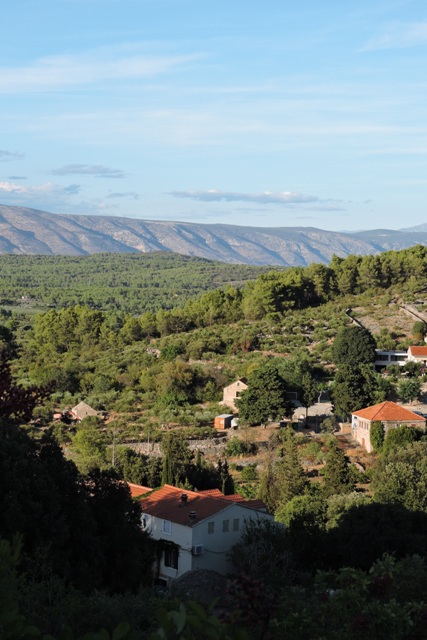
We have had some very welcome rain on Thursday. A total of 5 mm which has really refreshed everything.
I did have some loud complaints from the felines, who were less than impressed with the water droplets falling from the sky, but soon were curled up safely in their favourite spots. It must be nice to be a cat…
The boundary between the end of summer rain and the start of the autumn rains is ill defined, but which ever way you look at this summer’s rainfall, we are well down on the average.
This was just the right kind of rainfall too. It was light and over most of the day, so what we did receive has soaked in rather than just run off the top of the parched soils.
The trees are looking noticeably better and there is the forecast of more rain to come over the next few days too.
Tropical nights
A “Tropical Night” is defined in meteorological terms. It is any night where the temperature never drops below 20ºC.
Temperatures matter in this age of climate breakdown and this year I have added to my analysis of the data from my weather station.
In Croatian they are called “tropska noć” and we have had 74 this year. In addition I have also measured nights when the temperature never falls below 25ºC, called “Vrlo topla noć”.
We have only had three of those, but none the less they were extremely uncomfortable. Remember these are outside temperatures. Inside on those nights the temperature was above 30ºC.
Our summer has been hotter than average and it has also been dryer, with much less rainfall than could be expected.
The summer heatwave we have experienced is going to affect our weather for the remainder of the year.
Thinking back to basic physics at school, land heats faster than water, but also radiates heat easily and cools quicker. Water on the other hand is a good thermal store.
So when I read that the Mediterranean, especially the western Mediterranean is 5ºC hotter than average, it will affect us until New Year.
Europe is affected by the North Atlantic, which is in turn affected by the Pacific, via the Jetstream.
At a local level, air passing over a warm sea is heated, transferring the heat to the land it passes over.
It doesn’t help that the Adriatic is a very shallow sea and around the island of Hvar only 50 to 80 meters deep.
Updating my monthly spreadsheet of weather data, we have had sixteen days with a daytime temperature of over 35ºC and 74 days (with more to come) of over 30ºC.
Temperatures above 30ºC stress plants, and at 35ºC, most stop growing and become dormant.
I have been working all summer on identifing vegetables to plant, which will survive our summer heat and need little water. This together with the cardinal temperatures they need for growing.
Cabbage and cauliflower will be off the menu, but vegetables like Jicama, Okra, Hyacinth bean, Asparagus beans and Armenian Cucumber, with fruits like Mamey sapote, Tomatillo and Dragon fruit are all possible replacements..
I just have to find somewhere to get the seeds so I can try them next year…
Working on the Poly Tunnel
I was in Stari Grad early on Monday, and came back with some of those the things I need to make the frame for the poly tunnel in the Top Orchard.
Once back home I measured the frame using two 4 metre lengths of timber to get an idea of where I need to make the cuts to fit the timber around the steel hoops.
With that done I realised that I needed to cut the lap joints in the timber first, so it was back to the courtyard.
After the rain on Thursday, Friday was a fantastic day for working. cool enough to work outside comfortably all day long.
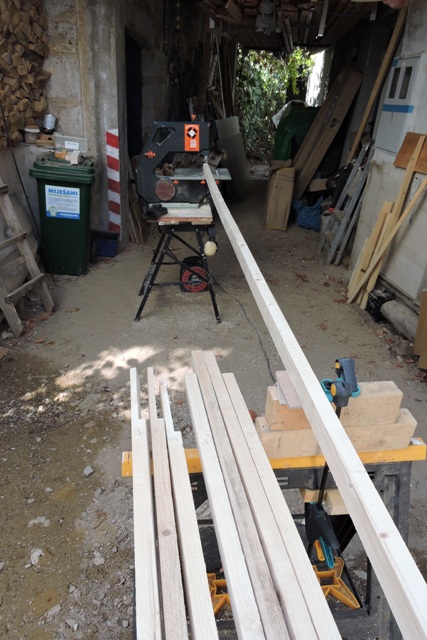
I measured and marked the lengths and then cut square ends followed by the rebaits for the lap joint on each length.
Because I am working with eight meters of timber, in two four meter pieces, I took the first pair down to the orchard before assembling them.
Manoeuvring a single eight metre length would be just too difficult.
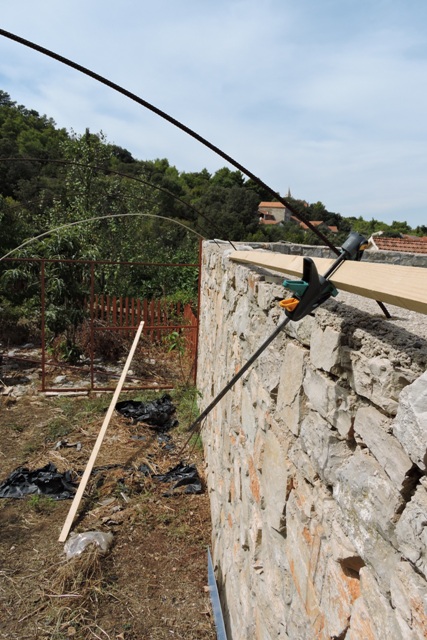
I also cut one of the polywall thermoplastic sheets into quarters.

This is because I want to harvest rainfall from the roof by having a small gap between two sheets, close to the wall, allowing water to run between and drip on the soil below.
The first fixing went well, but I did discover I need some more materials when the shops open again next week. Things like some 90º angle brackets and more plastic tubing.
Given that this construction is to my own plans, it is very much a DiY building. This of course means that there will always be small items I think of as construction progresses.

A little bit of poaching
What do you do when you are short of time and need something for supper? Do a bit of poaching…
I had a surprise invitation to dinner on Thursday afternoon, and needed a quick dessert to take with me.
There are still a lot of figs on the trees, all coming ripe now, so I slipped out between the rain drops and picked a plastic bag of figs from my tree.
These are the green Common Fig. My Brown Turkey, which have a nicer flavour are all finished.
It was then an easy job in the kitchen to dissolve sugar in water to make a syrup, add cinnamon, cardamom, three cloves and vanilla powder with a litre of red wine and bring the pan close to boiling.
I picked a lemon from the garden, zested and squeezed it and added both the zest strands and juice to the pan.
Finally I added the figs after cutting the stalks off and poached them gently in the liquid for 8 minutes, until they started to turn colour.
It is important not to overcook them, otherwise they loose their shape and become mushy.
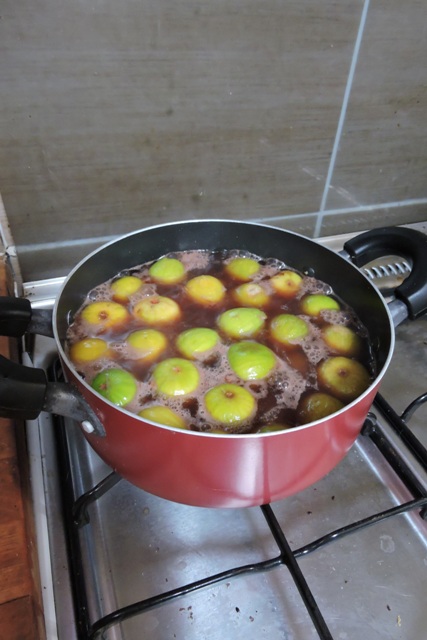
Removing the figs and putting them into a serving dish, I then brought the liquid up to a rolling boil, until ⅓ had evaporated and the remainder was a nice thick sauce.
At the end of the evening, there were not many figs left!
Sunrise, sunset
September 1st is the first day of Meteorological Autumn. With the change in season come clouds, something we have seen little of during the summer.
There have been a couple of nice sunrises this week. The change in light woke me, but by the time I had got outside, the best of the morning display of colour had gone.
Evenings are easier to capture. I can tell by early evening if there is likely to be a nice sunset.
This means that I have time to get my camera together, and go up into the Maquis to one of my vantage points, to take some photographs.
However much I try and sneak out without any of the felines noticing, I usually end up with some following, complaining loudly that I left them behind.
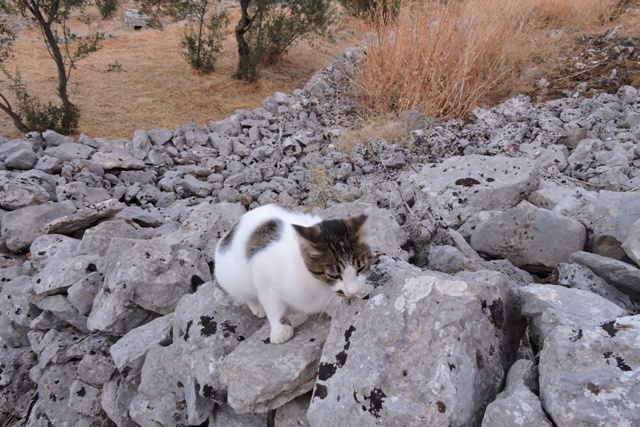
It is then just a matter of waiting until the subtle colours change and taking several photographs with different settings to try and do justice to the enfolding sunset.
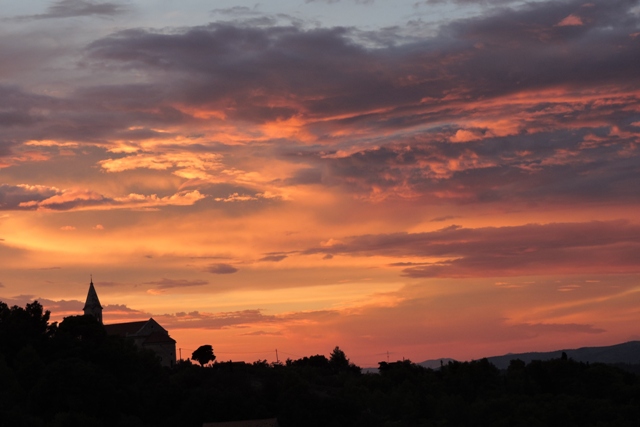
It is just so easy now to take multiple photographs, with a range of settings and then look to see which one is the best.
It reminded me of the days of Kodachrome 64 or 100ASA, and the lengths one went to to get the settings just right, because film was expensive.
Then you had to wait a few days, or as I used to take colour sides, often weeks to finish the film, send it of for developing and wait for the yellow box of slides to come back.
The same happens with night photography. I was in Stari Grad one evening this week and snapped these two photographs of the Riva around 22:30, still buzzing with people and music.
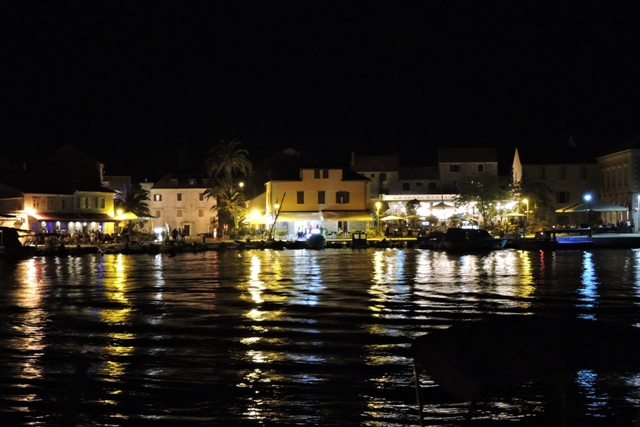
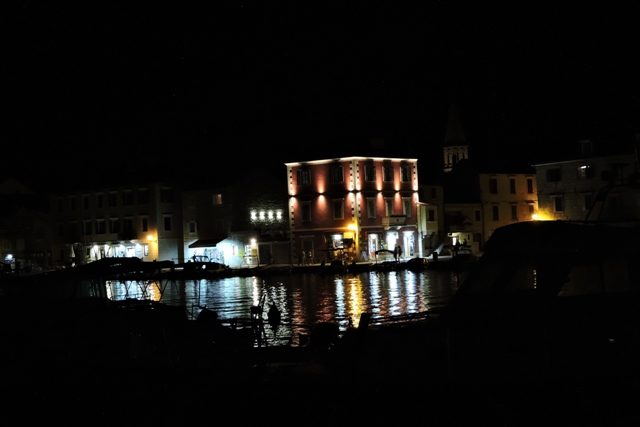
In the days of wet film process, I seldom did night time photography because I found getting good results was difficult. Now with a digital camera, you can see the results immediately.
Early morning call
Živa jumped on me just after 6am one morning this week.
With a persistent mieow, mieow, MIEOW! She clearly wanted me awake, NOW…
I followed as she raced ahead onto the terrace where she had left her latest “treasure”.

This was one freshly killed snake. I measured it and from nose to tail it as 54 cm and the thickness of my little finger.
So I told Živa she was clever and good for protecting the house and gave her (and the other felines) their breakfast.
I knew which snake is wasn’t – not one of our poisonous viper family of snakes, but I haven’t seen a snake with these markings before, so set about looking up the species.
With its yellow eyes and vertical eye slit and the black zig-zag stripes I soon found that it was a European Cat Snake, Telescopus fallax, which is endemic to the Mediterranean and Caucasus’s.
It feeds on lizards and geckos and inhabits the Garrigue and Maquis. The Cat Snake grows to 80 cm, so this was a young adult.
On the European conservation list, the Cat Snake is listed as of “least concern”, although all snakes are protected here in Croatia.
None of my other felines has ever brought me a snake, although I have seen them in the garden and orchard occasionally and have found their shed skins.
Živa is a tenacious hunter of reptiles, insects and butterflies, so much so that I introduce her as my Jägermeister – master hunter. NCG
One Response
Marcy
Hi, I loved the photos you took this week. I clicked on your DIY photography link and love those photos as well.
A long time ago in Abu Dhabi, I had a dessert of baked dark figs filled with clotted cream. It was the best dessert I think I had ever tasted. My grandmother had a fig tree in her backyard, and as a child, my brother and I picked and ate them as they ripened.
As always, thank you for sharing and enjoy the cool weather and rain. We are in the last throws of summer and the temperatures are high. Be safe, Marcy